In our initial analysis of ChatGPT’s role in flight search, we found a 13-fold increase in referral traffic from ChatGPT to airlines from November 2024 to July 2025, accounting for 1.42% of total organic traffic.
While this still represents a small slice of total organic traffic, its rapid growth is a clear signal that using ChatGPT for flight searches is no longer a fringe concept.
However, our follow-up research revealed that while airlines are mentioned frequently in ChatGPT’s flight-related answers, they are disproportionately denied a citation link. This “mention-to-link mismatch” can steer high-intent clicks away from carriers and toward Online Travel Agencies (OTAs) and aggregators.
We’ve traced this disconnect to six distinct causes, from technical oversights to critical content gaps on airline flight pages. This article moves our series from analysis to action. We will now provide a granular, tactical playbook for airlines, including concrete strategies to help score citation links and enhance visibility in ChatGPT.
Our recommendations, however, extend beyond ChatGPT and apply to the entire AI ecosystem, as well as traditional Google search.
6 Strategies to Win Citations on ChatGPT (That Also Work on Google)
While our analysis below used ChatGPT as the lens, these recommendations are not narrow, single-platform optimizations.
In fact, as of late 2025, optimizing flight pages for AI search remains largely the same as optimizing them for Google. The principles of so-called Generative Engine Optimization (GEO) are deeply intertwined with modern SEO best practices.
The proof is in the data: roughly six out of ten of ChatGPT’s citation links already overlap with Google’s first-page results in flight searches. This confirms that a single, unified strategy now serves both traditional Google search and AI search. The pages that win in both categories are the ones that are accessible, indexable, and rich in fares, flight information, and booking insights.
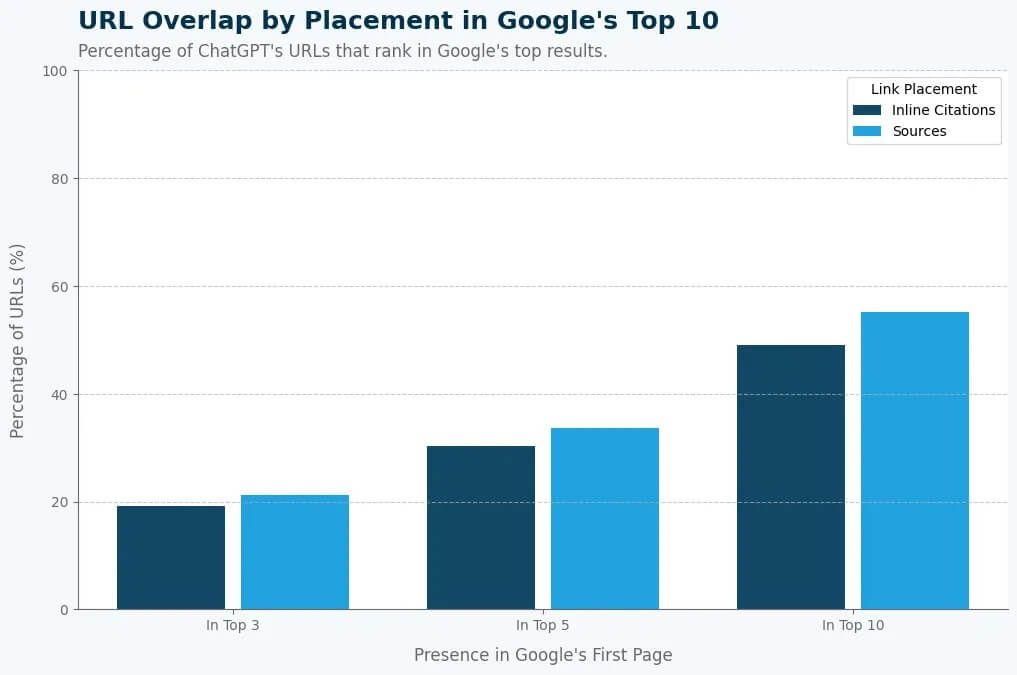
| Presence in Google’s First Page | Inline Citations (% Overlap) | Sources (% Overlap) |
|---|---|---|
| In Top 3 | 19.17 | 21.15 |
| In Top 5 | 30.27 | 33.66 |
| In Top 10 | 49.09 | 55.17 |
This principle extends across the entire AI ecosystem, including Google’s AI Mode and Perplexity. They operate on the same logic, seeking out the most structured, authoritative flight information to guide a user’s booking decision. For airlines, this means enriching the point of sale.
1. If a Route Exists, The Page Must Exist
One of the most fundamental reasons airlines lose out on citation links is that, for a significant number of routes, the specific flight page ChatGPT expects to find doesn’t exist on the airline’s website.
In contrast, OTAs and aggregators excel here by programmatically creating pages for nearly every conceivable route. When ChatGPT seeks a source for a specific flight, it finds a perfectly matched page on an OTA. The result is that the OTA gets the citation and the referral click.
To score more inline citations, airlines must create a unique and indexable landing page for every route they operate, including multi-leg flights.
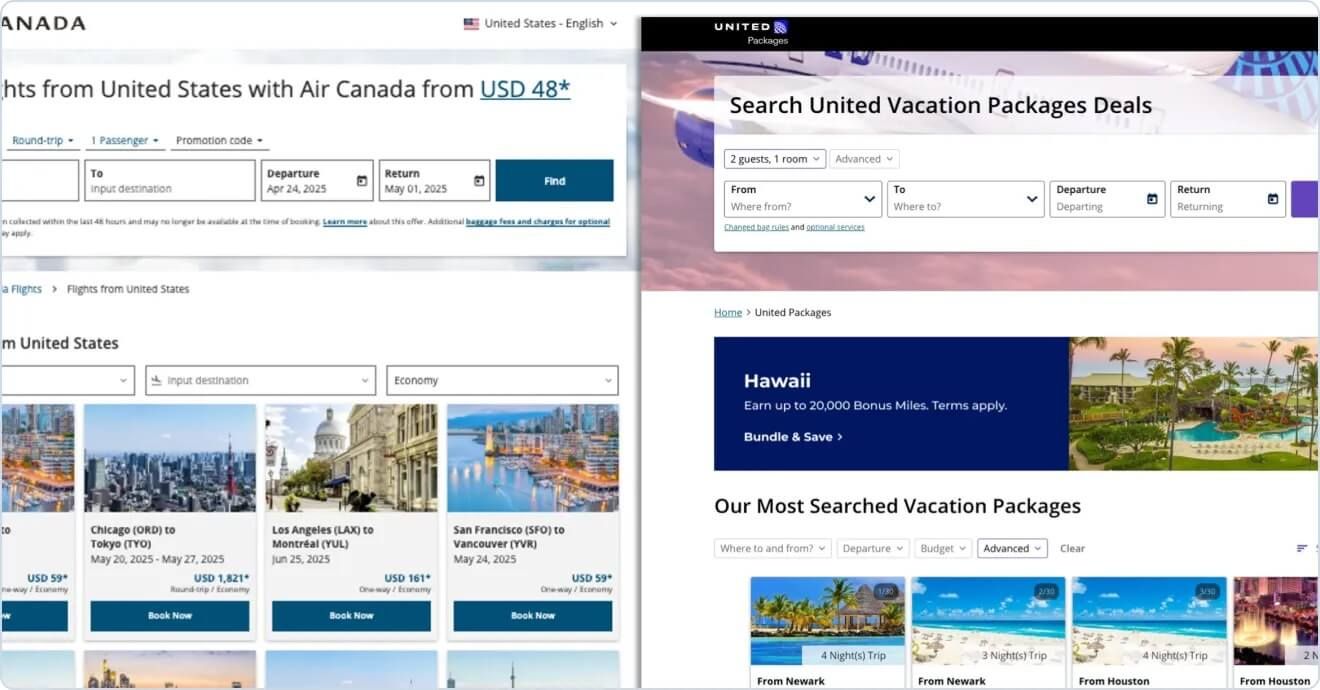
Of course, manually creating thousands of route-specific pages is unlikely to be feasible. Here is where scalable flight page automation solutions like airTRFX become essential. airTRFX is explicitly designed to enable airlines to programmatically generate SEO/AI-friendly landing pages for every airline’s route.
2. Make Every Fare Findable
Incomplete fare coverage is a common but critical issue on airline flight pages. Our research revealed that many carriers display only round-trip or one-way fares, and in some cases, no prices at all.
ChatGPT often provides a comprehensive answer to a flight search prompt, which involves generating comparison tables and summarizing all available flights. For example, when a flight page lacks a round-trip price, ChatGPT may indicate that it is “Not listed.”
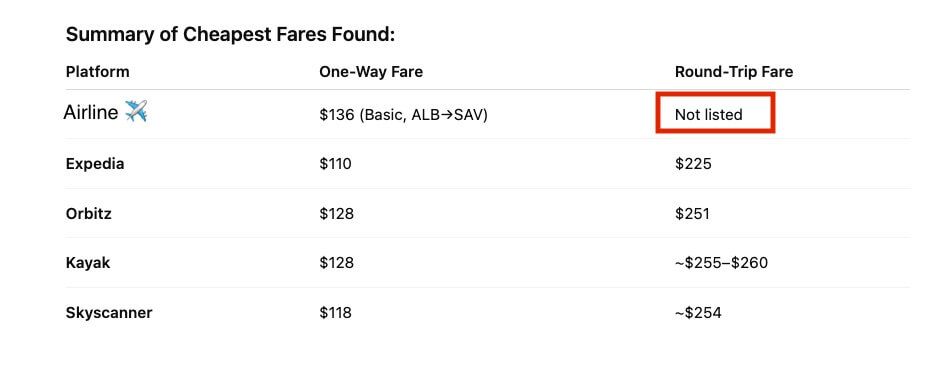
OTAs like Expedia are often cited because their pages are data-rich, presenting fares across multiple sections, from meta descriptions and H2 tags to dedicated fare modules for one-way, round-trip, and multi-class deals.
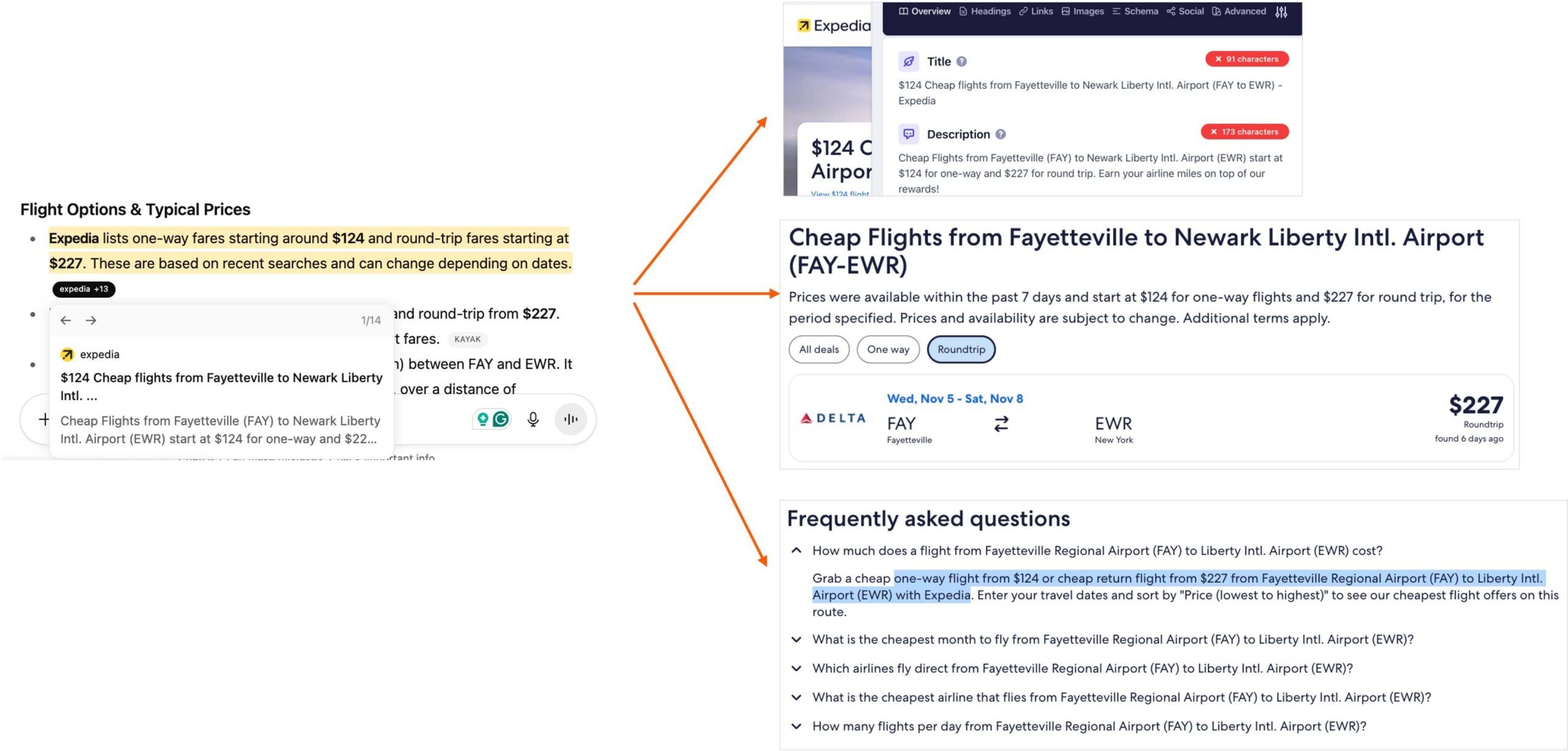
To win citation links, flight pages must programmatically display a wide array of pricing options. Airlines can achieve this by leveraging highly customizable modules, such as our airTRFX Dynamic Pricing airModules (DPA), to showcase:
- Available Fares in Current Month
- One-Way and Round-Trip Fares
- Direct vs. Connecting Flight Prices
- Last-Minute Flight Deals
- Fares by Cabin Class (Economy, Business, First)
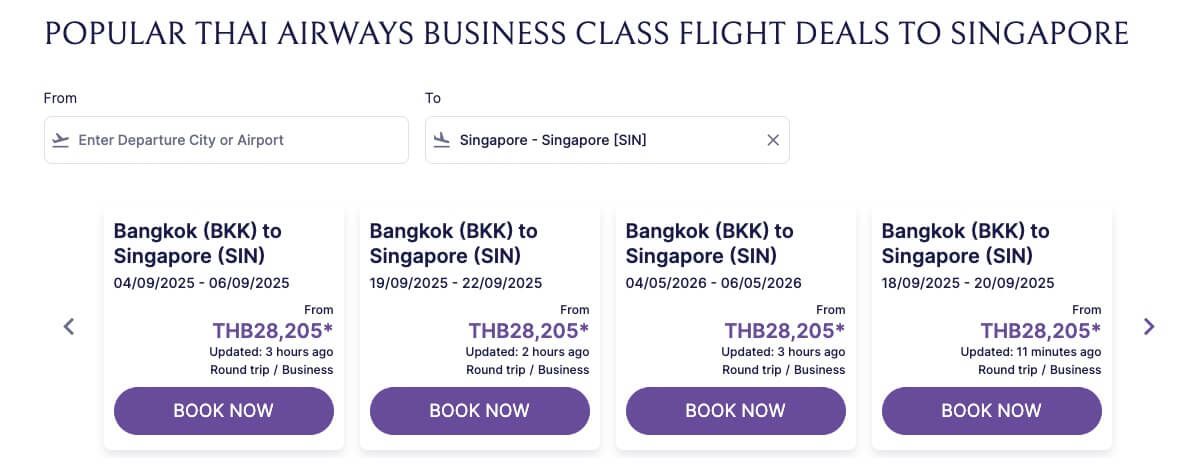
Additionally, optimize fare modules, including a descriptive heading and subheading with the minimum (e.g., “Recent economy round-trip fares for your flight from [origin] to [destination] start at $XXX”).
3. Provide Rich, Citable Flight Details
Airlines most often lose the citation link when ChatGPT discusses topics like “Layover & Connections” and “Flight Duration & Distance.” This is because airline pages are data-poor, lacking detailed flight information, which prompts ChatGPT to cite a third-party source that does provide this context.
OTAs and aggregators treat this contextual data as a core asset. They present it in clean, easily parsable formats, such as HTML tables and structured FAQ sections, making it effortless for ChatGPT to extract and reference.
For example, leading players consistently provide modules with key “flight facts,” using clear visualizations:
Expedia’s HTML table with flight information:

Flights.com’s FAQs about flight frequency:
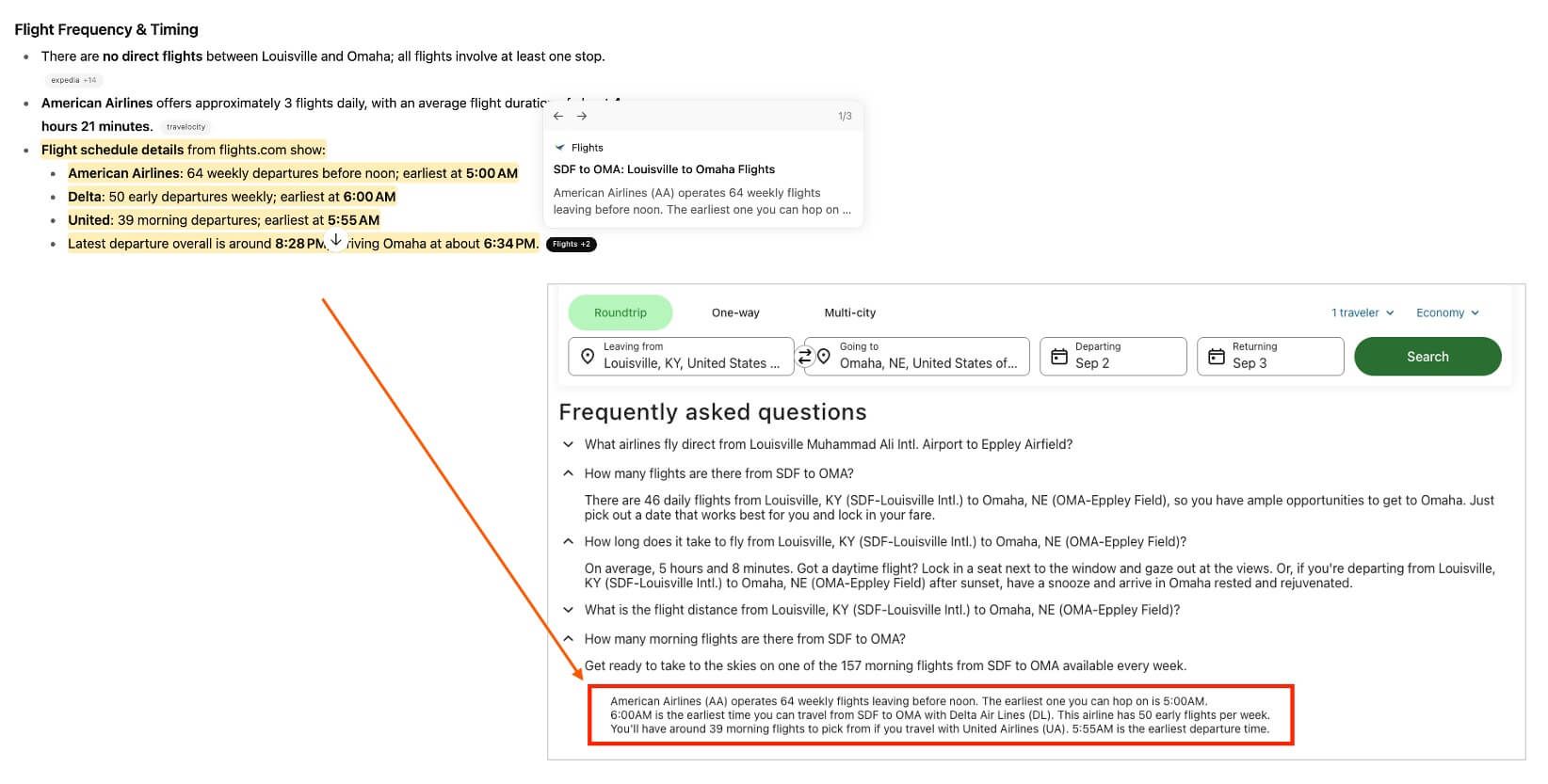
To become the authoritative source for their own routes, airlines must enrich flight pages with a concise, easy-to-read overview of key flight information, including:
- Typical flight time and route distance
- Flight frequency (e.g., daily, weekly) and scheduling
- Detailed layover and connection information
- Departure and arrival airports, including terminal information
- Aircraft type used on the route
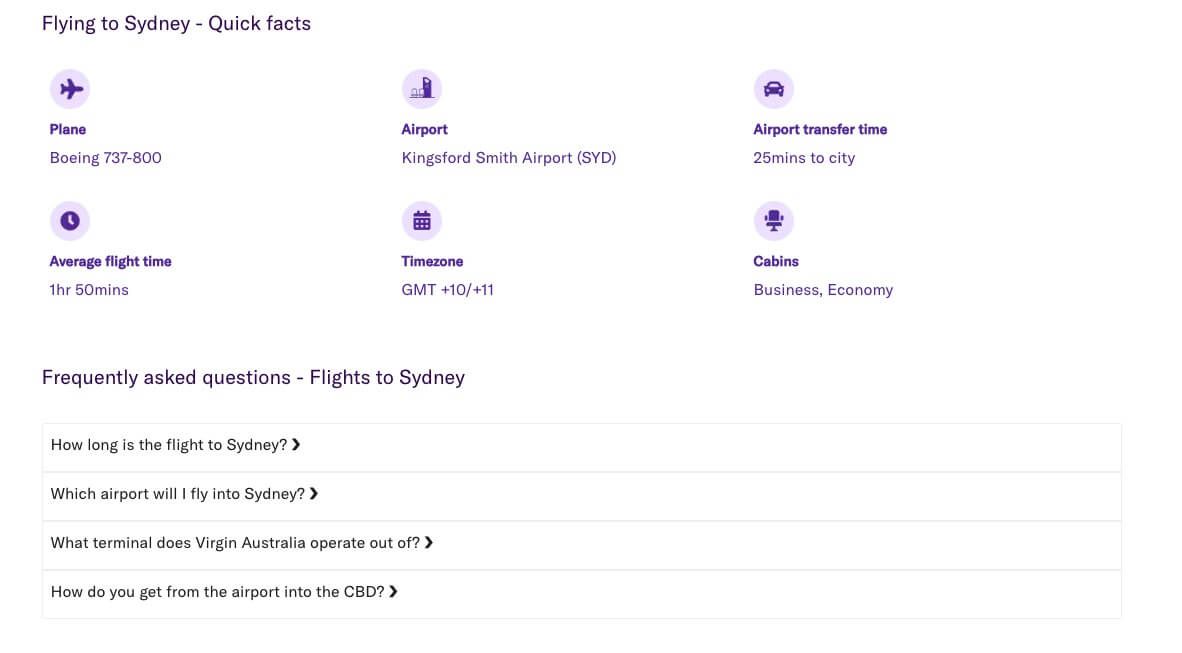
Airlines using the airTRFX platform, for instance, can leverage our dynamic Quick Flight-Facts Widget to populate pages with flight data automatically. Alternatively, you can add this information manually to ensure ChatGPT has no reason to look elsewhere for facts about your flights.
4. Offer Actionable Booking Insights
Beyond listing routes and fares, ChatGPT routinely dedicates space, often whole paragraphs or tables, to booking advice.
OTAs and aggregators package historical data into digestible, citable formats, enabling users to make more informed booking decisions. In the example below, Kayak’s data-rich guidance dominates an entire section of ChatGPT’s answer, earning multiple inline citations.
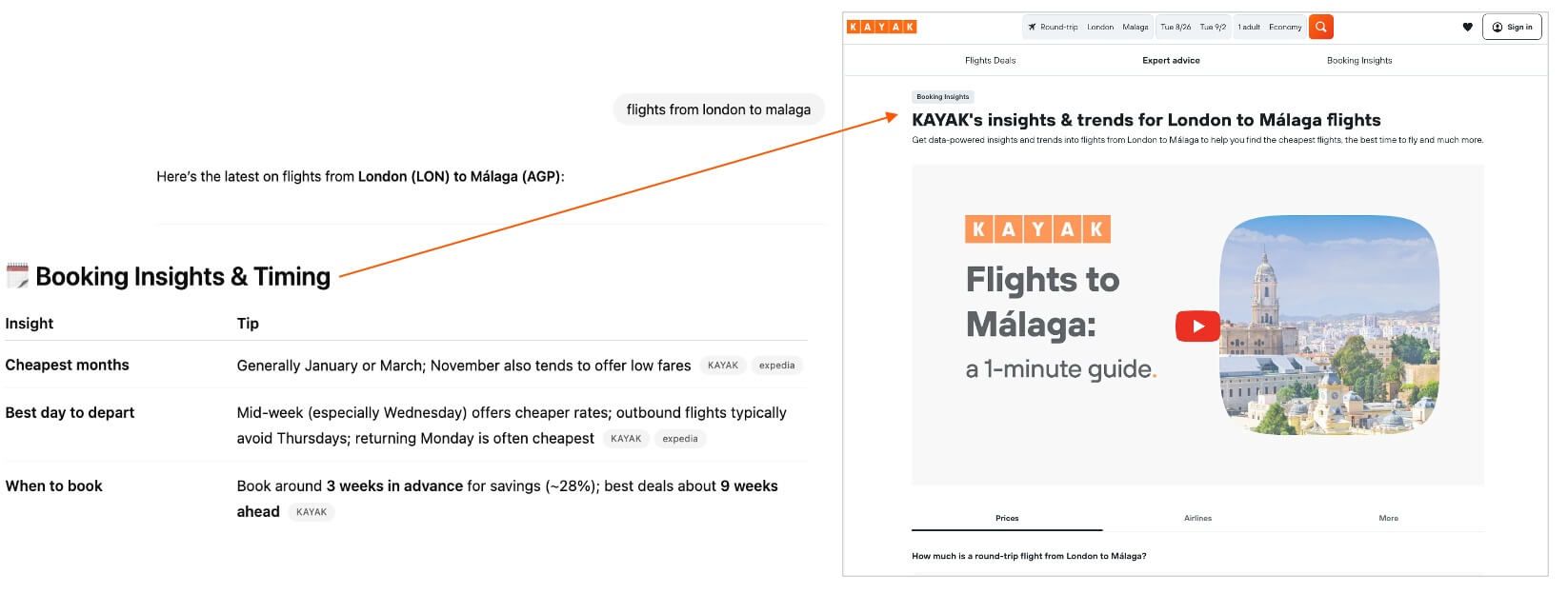
Airlines are sitting on a treasure trove of first-party booking data. The key is to transform this data from an internal analytics tool into a valuable, public-facing asset.
Prioritize insights that answer the most common user questions:
- The cheapest month(s) to fly the route.
- The best day(s) of the week to book or travel.
- The optimal booking window (e.g., “Book 45-60 days in advance for the best price”).
- Time-of-day travel insights (e.g., “Early morning flights are often cheaper”).
Adding descriptive graphs or modules with crisp, time-boxed guidance can help establish a flight page as the definitive source for booking intelligence in ChatGPT answers.
5. Avoid Client-Side Rendering for Fares and Critical Content
Many modern airline websites rely on client-side JavaScript to dynamically load and display key content, especially fare data and interactive modules.
However, the bots that power AI apps like ChatGPT (ChatGPT-User, OAI-SearchBot) are not guaranteed to execute JavaScript. This creates a critical blind spot: if your most crucial content only appears after scripts run in the user’s browser, the AI bot may never “see” it.
From ChatGPT’s perspective, a page with fares rendered on the client-side is functionally identical to a page with no fares at all. This technical oversight is a direct path to being ignored as a citable source, effectively rendering your rich content invisible and irrelevant to the model.
The solution is to ensure all citable content is server-rendered. This means that prices, flight information, FAQ sections, and fact widgets must be present in the raw HTML source code. This guarantees that even the simplest crawlers can parse the full value of your page, making your data eligible for inclusion in ChatGPT’s answers and inline citations.
6. Open the Door to OpenAI Bots
There is a simple gatekeeping issue that can render an airline completely invisible to ChatGPT: restricting OpenAI’s crawlers. Our server logs confirm it is a major, self-inflicted reason for the high unlinked rate plaguing airlines.
For example, the data below belongs to an airline that allows ChatGPT-User to crawl its site, resulting in a volume of 5.92 million requests in the last 30 days.
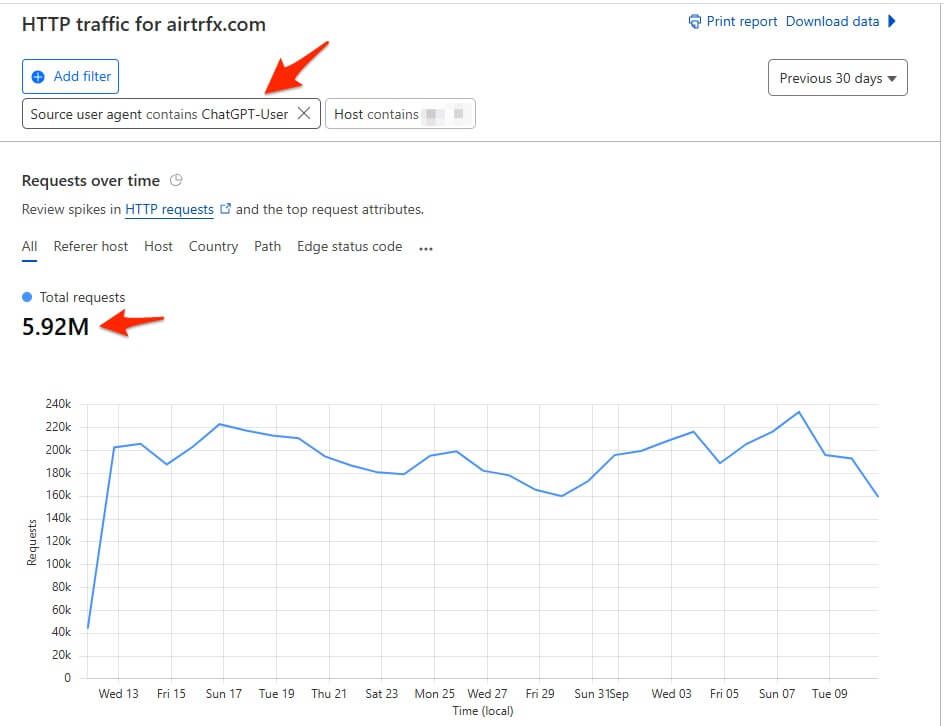
In contrast, a second comparable carrier that restricts ChatGPT-User shows only 1,040 requests getting through in the last 30 days. This carrier is effectively absent in ChatGPT’s citation links.
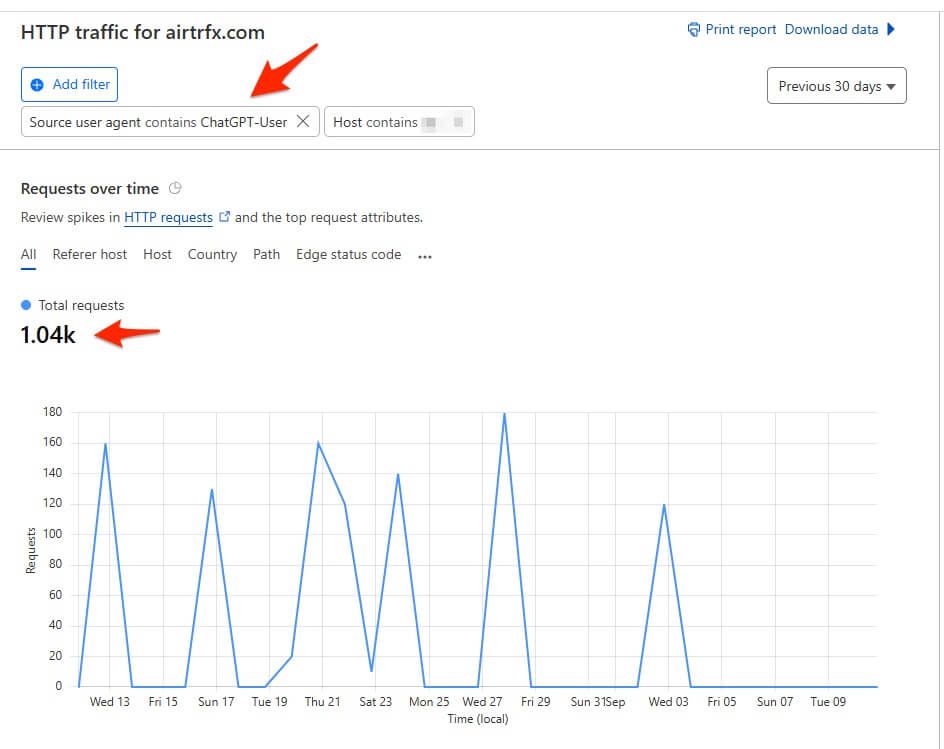
The fix is straightforward: do not restrict OpenAI’s crawlers. If ChatGPT-User or OAI-SearchBot is blocked, your airline cannot be a citable source, no matter how rich the on-page content is.
Conclusion: Optimize for a Unified Search Ecosystem
Today, airlines are earning brand mentions in ChatGPT, while OTAs and aggregators are capturing the clicks. An unlinked rate of nearly 75% for airlines in ChatGPT is not a statistical quirk; it is a significant and preventable loss of direct bookings.
This article moves our series from diagnosis to direct action, including a series of foundational improvements in content and technology. By ensuring every route has a page, every page has comprehensive fare and flight data, and every OpenAI bot has access, airlines can systematically close the gaps that force ChatGPT to cite third-party sources.
The good news is that the strategies detailed here apply not only to ChatGPT but also to the entire AI ecosystem and even to traditional Google search. Beyond closing the mention-to-link mismatch, this approach positions airlines to reduce OTA dominance and improve visibility in both AI apps and search engines.
Frequently Asked Questions
Airlines can boost visibility by ensuring every route has an indexable landing page, enriching flight content with fares, flight facts, and booking insights, and allowing OpenAI crawlers to access their sites. These steps make airline pages easier for AI engines to parse, cite, and rank.
OTAs like Expedia and Kayak programmatically create pages for every route and include structured fare data, FAQs, and booking advice—content that ChatGPT favors. Some airlines miss the link citation because they lack complete route coverage or rely on JavaScript rendering, making their content invisible to AI crawlers.
To win citations, airlines should:
Create route-specific, SEO-friendly pages.
Include comprehensive fare data for all flight types.
Use structured modules (e.g., airTRFX DPAs).
Add flight facts (duration, layovers, distance).
Ensure server-side rendering and OpenAI crawler access.
airTRFX allows airlines to automatically generate flight pages for every route, complete with dynamic pricing modules, structured data, and SEO/AI-optimized content. This ensures visibility across ChatGPT, Google AI Mode, and Perplexity by giving AI models the data they need to cite airline sources directly.
Make sure fares and key content are server-rendered, and verify that ChatGPT-User and OAI-SearchBot aren’t blocked at either the server or robots.txt level. These technical optimizations help AI crawlers access and cite your data more effectively.
Airlines can monitor AI referral traffic using tools like GA4. See our latest guide on how to track LLM referral traffic. However, there are many tools in the market, such as Ahrefs, SEMrush, and TryProfound, that provide AI visibility dashboards that can help airlines benchmark progress and measure citation wins.

Enmanuel Tirado
Enmanuel Tirado is the Head of SEO & Digital Analytics at PROS Holdings, based in Houston, Texas. A recognized thought leader in airline SEO, Enmanuel has designed cutting-edge SEO strategies for over a hundred airlines. Under his direction, PROS’s SEO solutions have driven multimillion-dollar annual organic revenue increases for national and international carriers. Enmanuel also combines deep industry expertise with statistical analysis to establish benchmarks and best practices that have revolutionized the airline SEO landscape. His work extends beyond traditional SEO, encompassing digital analytics, conversion rate optimization, and product performance measurement across PROS’ solution portfolio. Some of his notable publications include “The Ultimate SEO Guide Airlines,” “Core Web Vitals Optimization for Airlines,” and “The Indexing of Google Fights: The Empire Strikes Back.” His work is regarded as the gold standard in airline SEO, making him one of the most sought-after experts in this highly specialized field.
More Content by Enmanuel Tirado

